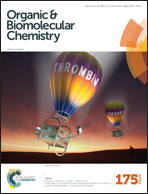Use of hydrostatic pressure for modulation of protein chemical modification and enzymatic selectivity†
Abstract
Using hydrostatic pressure to induce protein conformational changes can be a powerful tool for altering the availability of protein reactive sites and for changing the selectivity of enzymatic reactions. Using a pressure apparatus, it has been demonstrated that hydrostatic pressure can be used to modulate the reactivity of lysine residues of the protein ubiquitin with a water-soluble amine-specific homobifunctional coupling agent. Fewer reactive lysine residues were observed when the reaction was carried out under elevated pressure of 3 kbar, consistent with a pressure-induced conformational change of ubiquitin that results in fewer exposed lysine residues. Additionally, modulation of the stereoselectivity of an enzymatic transamination reaction was observed at elevated hydrostatic pressure. In one case, the minor diasteromeric product formed at atmospheric pressure became the major product at elevated pressure. Such pressure-induced alterations of protein reactivity may provide an important new tool for enzymatic reactions and the chemical modification of proteins.


 Please wait while we load your content...
Please wait while we load your content...